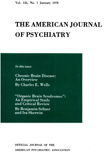Relationship of neuroleptic drug effects at brain dopamine, serotonin, alpha-adrenergic, and histamine receptors to clinical potency
Abstract
The authors examined the potencies of 22 neuroleptic drugs competing for binding sites associated with dopamine, serotonin, alpha- adrenergic, and histamine receptors in brain membranes. They found that although many neuroleptics are quite potent in competing at several of these receptor sites, the average antipsychotic clinical potency correlates closely only with the drug affinity for dopamine receptors labeled by 3H-spiroperidol At clinically effective doses, however, substantial occupancy of serotonin, alpha-adrenergic, and histamine receptors often occurs and may account for some of the auxiliary actions of neuroleptics.
Access content
To read the fulltext, please use one of the options below to sign in or purchase access.- Personal login
- Institutional Login
- Sign in via OpenAthens
- Register for access
-
Please login/register if you wish to pair your device and check access availability.
Not a subscriber?
PsychiatryOnline subscription options offer access to the DSM-5 library, books, journals, CME, and patient resources. This all-in-one virtual library provides psychiatrists and mental health professionals with key resources for diagnosis, treatment, research, and professional development.
Need more help? PsychiatryOnline Customer Service may be reached by emailing [email protected] or by calling 800-368-5777 (in the U.S.) or 703-907-7322 (outside the U.S.).



